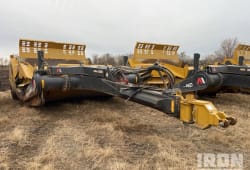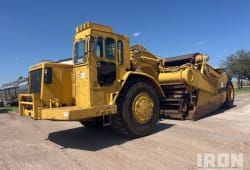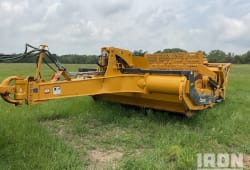Inspecting Heavy Equipment Scrapers: A Step-By-Step Guide
11 Min read
)
November 17, 2023
Mario Ramirez, an expert heavy equipment inspector at Boom & Bucket, shares his deep expertise in heavy equipment inspection so you can make better buying decisions.
Inspecting heavy equipment scrapers is an essential task for anyone responsible for maintaining and operating these powerful machines. Regular inspections not only ensure the safety of workers but also help identify potential issues early, extend the lifespan of the equipment, and ensure operational efficiency. In this step-by-step guide, we will explore the importance of scraper inspections, the basics of heavy equipment scrapers, pre-inspection preparation, and how to conduct a thorough visual inspection.
Understanding the Importance of Regular Scraper Inspection
Regular inspection of heavy equipment scrapers is crucial for several reasons. Firstly, it allows you to identify potential issues before they escalate into costly repairs or serious accidents. By catching problems early, you can take prompt action to prevent further damage and ensure the safety of your workforce.
For example, during a routine inspection, you may notice a crack in the scraper blade. This seemingly minor issue, if left unaddressed, could lead to the blade breaking while in use, posing a significant safety risk to the operator and those nearby. By identifying the crack early on, you can arrange for the blade to be repaired or replaced, preventing a potential accident and ensuring the continued smooth operation of the equipment.
Secondly, regular inspections help extend the lifespan of your equipment. By maintaining and addressing any issues promptly, you can minimize wear and tear and keep your scrapers running smoothly for an extended period. This proactive approach can save you significant time and money in the long run.
During an inspection, you may discover that the scraper's hydraulic system is showing signs of wear. If left unattended, this could lead to leaks or malfunctions, resulting in costly repairs and downtime. However, by identifying the issue early on, you can arrange for the necessary repairs or maintenance to be carried out, ensuring the hydraulic system operates optimally and preventing further damage to other components.
Elevating scrapers, a subset of self-propelled scrapers, are designed to load material efficiently through their vertical blade. These earthmoving machines boast impressive capabilities for digging and transporting materials. The elevated hopper ensures a seamless process of loading, making it indispensable on construction sites.
Lastly, ensuring operational efficiency is another vital aspect of scraper inspections. By conducting regular checks, you can identify any inefficiencies or malfunctions that may hinder performance. Addressing these issues promptly can enhance productivity and prevent costly downtime.
For instance, during an inspection, you may notice that the scraper's engine is not running at its optimal capacity. This could be due to a clogged air filter or a faulty fuel injector. By identifying and rectifying these issues, you can restore the engine's efficiency, allowing the scraper to operate at its full potential and complete tasks more effectively.
Earthmoving machines play a pivotal role in the realm of heavy machinery and construction equipment. Among the various types, elevating scrapers and wheel tractor scrapers stand out for their efficiency and versatility.
In conclusion, regular scraper inspections are essential for maintaining the safety, longevity, and operational efficiency of heavy equipment. By identifying potential issues early on and taking prompt action, you can prevent accidents, minimize downtime, and save valuable time and money in the long term.
The Basics of Heavy Equipment Scrapers
:format(webp))
Before diving into the inspection process type scrapers, let's familiarize ourselves with the key components and common types of heavy equipment scrapers.
Heavy equipment scrapers are powerful machines used in construction and mining industries to move large quantities of earth and other materials. They are essential for tasks such as land levelling, road construction, and excavation.
Key Components of a Scraper
A scraper consists of several essential parts that work together to accomplish earth-moving tasks. Understanding the role of each part is crucial in identifying potential issues during inspections.
The tractor is the main component of a scraper and provides the power and mobility needed to operate the machine. It is equipped with a powerful engine and sturdy tires to handle rough terrains.
The bowl is a large container located at the front of the scraper. It collects and carries materials such as soil, gravel, or rocks. The capacity of the bowl varies depending on the size of the scraper.
The apron is a movable plate located at the bottom of the bowl. It controls the flow of materials into the bowl and prevents spillage during transportation.
The ejector is a hydraulic mechanism or machinery that pushes out the collected material from the bowl. It ensures efficient unloading of the materials at the desired location.
The cutting edge is a replaceable blade located at the front of the bowl. It is responsible for cutting through the earth and loosening the materials for collection.
The hydraulic systems of wheel tractor and a scraper power various components and facilitate efficient operation. They control the movement of the apron, ejector, and other hydraulic functions.
Common Types of Heavy Equipment Scrapers
There are various types of heavy equipment scrapers available, each designed for specific applications. Familiarizing yourself with the different scraper types can help you assess the specific requirements of your site and equipment during inspections.
Motor scrapers are self-propelled machines that combine the functions of engines, a tractor and a scraper. They are versatile and can handle a wide range of earth-moving tasks.
Pull scrapers are towed behind a tractor or another vehicle. They are commonly used for lighter earth-moving tasks and are more cost-effective compared to motor scrapers.
Elevated scrapers are specialized machines used for high-volume earth-moving projects. They have an elevated bowl that allows for increased capacity, speed and efficiency.
Understanding the Function of Each Part
To ensure effective inspections, it is important to understand the function of each part in a scraper.
The tractor provides the power and mobility needed to load and operate the scraper. It is equipped with advanced technology and controls for efficient manoeuvrability.
The bowl collects and carries materials during the earth-moving process. It is designed to withstand heavy loads and is made from durable materials.
The apron controls the flow of materials into the bowl. It can be adjusted to regulate the amount of material being collected and prevent overflow.
The ejector pushes out the collected material from the bowl. It is operated hydraulically and ensures efficient unloading at the desired location.
The cutting edge is responsible for cutting through the earth and loosening the materials for collection. It is made from hardened steel to withstand the abrasive nature of the materials.
Additionally, the hydraulic systems power various components of the scraper. They provide the necessary force and control for the movement of the apron, ejector, and other hydraulic functions.
By understanding the function of each part, inspectors can identify potential issues and ensure that the scraper is operating at its optimal performance. Regular inspections and maintenance are essential to keep the scraper in good working condition and prevent costly breakdowns.
Pre-Inspection Preparation
Before starting the inspection process, proper preparation is essential. This includes gathering the necessary tools, considering safety measures, and setting up an inspection schedule.
When it comes to gathering the necessary tools for a thorough inspection, it's important to be well-equipped. A flashlight will come in handy when examining hard-to-reach areas with limited lighting. A measuring tape will allow you to accurately assess dimensions and ensure everything is in the right place. An inspection mirror can be useful for inspecting hidden or tight spaces that are difficult to access. A pry bar will assist in checking for any loose or damaged components that may require attention. Lastly, having a camera to document any findings will provide visual evidence and aid in further analysis.
Prioritizing safety during inspections is of utmost importance. It is crucial to wear proper personal protective equipment (PPE) such as gloves, safety glasses, and steel-toed boots. These protective measures will shield you from potential hazards and minimize the risk of injury. Additionally, before commencing the inspection process, ensure that all equipment is turned off and that all moving parts have come to a complete stop. This precautionary step will prevent accidents and ensure a safe working environment.
Establishing a regular inspection schedule is crucial to ensure consistent maintenance of your scrapers. Consider the frequency at which the equipment is used and the nature of the tasks performed. By adhering to a schedule, you can stay proactive in identifying any potential issues before they escalate into major problems. Regular inspections will also help maintain optimal performance and extend the lifespan of your equipment.
Remember, thorough pre-inspection preparation sets the foundation for a successful inspection process. By gathering the necessary tools, considering safety measures, and setting up an inspection schedule, you can ensure that your inspections are comprehensive, efficient, and effective.
A Quick Guide to Use Scrappers
Conducting a Thorough Visual Inspection
Visual inspections play a vital role in identifying visible damage and assessing the overall condition of your heavy equipment scrapers. By conducting regular inspections, you can catch potential issues early on and prevent costly repairs down the line.
When it comes to inspecting your scrapers, it's important to be thorough and pay attention to detail. In this guide, we will walk you through the steps of conducting a comprehensive visual inspection to ensure the safe and efficient operation of your equipment.
Checking the Exterior for Visible Damage
Start by visually inspecting the exterior of the scraper. Look for any dents, cracks, or signs of corrosion on the frame, body, and other external components. It's essential to pay close attention to areas that are prone to wear and tear, such as the cutting edge, bowl, and hydraulic lines.
Take your time to carefully examine each component, documenting any visible damage for further evaluation and repair if needed. Remember, even small cracks or dents can worsen over time and compromise the integrity of the scraper.
Inspecting the Interior Components
After examining the exterior four wheel tractor scraper, move on to inspecting the interior components of the scraper. This step is crucial as it allows you to assess the condition of vital parts that directly impact the performance of the equipment.
Check all the vital parts, such as the bowl, apron, ejectors, and hydraulic systems for any signs of leaks, loose connections, or abnormal wear. Pay close attention to hydraulic hoses and fittings, ensuring they are secure and not damaged. Any issues found should be documented for proper rectification.
Additionally, it's important to inspect the control panel and gauges to ensure they are functioning properly. Faulty controls or inaccurate readings can lead to operational inefficiencies and potential safety hazards.
Assessing the Undercarriage and Tires
The undercarriage and tires are critical components that directly affect the performance and manoeuvrability of the scraper. It's essential to inspect them thoroughly to identify any potential issues.
Inspect the undercarriage for signs of excessive wear, misalignment, or damaged rollers and idlers. Pay close attention to the condition of the trackpads, ensuring they are not worn down or missing. Any abnormalities should be addressed promptly to maintain optimal performance and prevent further damage.
Next, check the condition of the tyres. Look for sufficient tread depth and ensure there are no visible cuts or punctures. Proper tyre maintenance is crucial for traction and stability, especially when operating in challenging terrains.
Inspecting heavy equipment scrapers is a meticulous process that requires attention to detail. By understanding the importance of regular inspections, familiarizing yourself with the basics of scrapers, pre-inspection preparation, and conducting thorough visual inspections, you can ensure the safe and efficient operation of your heavy equipment operators. Remember, proactive maintenance and timely repairs are key to maximizing the lifespan and performance of heavy equipment scrapers.
Visit Boom & Bucket to buy and sell your machinery.

Javier Bocanegra is Boom & Bucket's Technical Resolutions Lead, drawing on 10+ years in automotive and heavy equipment to diagnose issues, resolve complex post-sale cases, and keep machines - and customers - running smoothly. A certified heavy-equipment specialist, he's known for meticulous inspections and hands-on expertise across mechanical, electrical, and hydraulic systems. Based in Sacramento, Javier partners closely with buyers, vendors, and our field teams to deliver reliable outcomes and uphold our standards for safety and trust.














